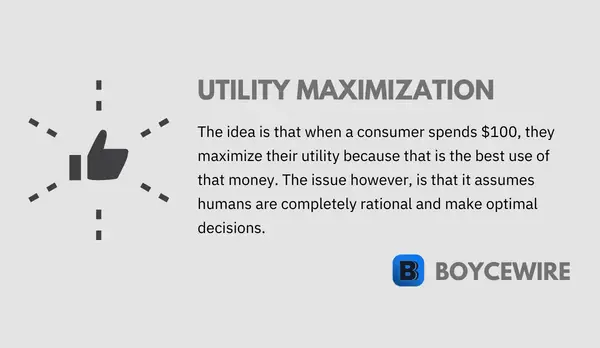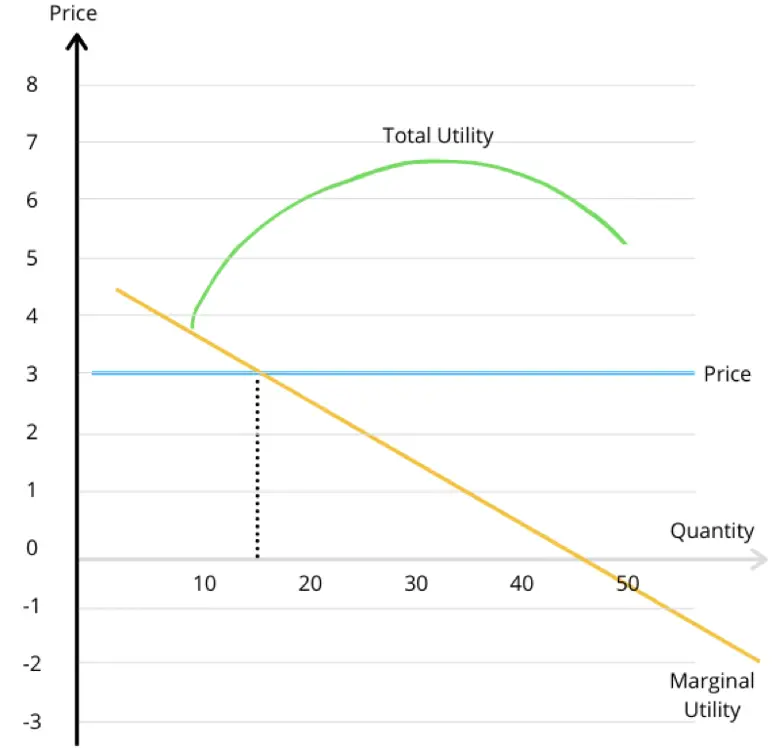Utility Maximization: Definition, Example & Limitations

What is Utility Maximization
Utility maximisation is the concept that consumers and businesses seek to maximise their satisfaction or utility from their purchases. In other words, when $100 is spent, then $100 worth of utility is received.
Neither consumers nor businesses choose an option which would provide a lower level of utility over another option. For example, a consumer in the store is faced with the choice between two chocolate bars. They are both priced at $1 each. Chocolate bar A gives the consumer a utility of $1, whilst Chocolate bar B provides a utility of $0.95.
In turn, the consumer logically picks Chocolate bar A as it provides the greatest amount of utility. Consumers will pick what provides them the greatest satisfaction at any certain point in time. However, that decision of maximising utility may change the next day as they value Chocolate bar B more.
Key Points
- Utility Maximization is where consumers or businesses meet the optimal point where any further consumption would create a negative impact on utility.
- Consumers and business maximize utility when there is no surplus left. In other words, they pay exactly what they value the product at.
- Budgets can play an important role in preventing consumers from being able to maximize utility.
There is also the fact that many consumers will actually receive greater utility than they actually pay. For instance, some consumers will purchase a doughnut for a price of $2. Although the utility they receive is over $3, they only paid $2 for it — meaning there is a consumer surplus of over $1.
For an additional doughnut, the consumer may value it less than the previous one — perhaps $2.50. For another, it would be even less — perhaps $2. It is at this point by which utility is maximised. This is because the cost of the good matches exactly the consumers utility. To purchase another would represent a loss of utility as the consumer doesn’t value the good more than what they paid for it.
Utility Maximization Rule
Utility is maximised when price is equal to marginal utility. The issue is that there are many goods in the market that the consumer can spend their money on. For instance, the utility received by Consumer A in consuming a bag of chips will start to decline after one bag. In fact, it may decline below its actual price meaning the consumer no longer wants to buy anymore.
However, utility is only maximised when there is no other good that represents a utility value that is equal or greater than a goods price. For instance, Consumer A may no longer receive further utility from a bag of chips, but would from a bar of chocolate. Only once Consumer A no longer receives a utility that is greater than the price will utility be maximised.
This can be demonstrated by the graph below:

The rule of utility maximisation is simple. If the consumer feels a good brings them more utility than it costs, then they will continue to buy it up to a point whereby it no longer does. If we look at the previous graph, utility maximisation occurs when quantity is at 15.
At this point, the marginal utility has decreased to a point whereby it is equal to the price of the good. The purchase of any further goods will result in a net loss in utility as its value is lower than the cost. So the consumer would be paying more for the good than the utility they receive.
Utility Maximization Example
Luke has a decision to make between cakes and pastries. He wants to maximise his utility and has to decide whether to buy more cakes or more pastries. The table below shows details on this decision.
| Cake | Pastries | |
| Quantity | 2 | 5 |
| Price per unit | $5 | $1.50 |
| Marginal utility of last unit | 20 | 12 |
If Luke wants to maximise his utility, it may seem like he should just buy more cake. However, this doesn’t factor in the utility per dollar. For example, a Ferrari would represent far greater utility to some than a Ford Fiesta — yet it is hundreds of thousands more expensive. So it is important to compare like for like on a per dollar basis. Looking at the example, the utility per dollar can be calculated by dividing the marginal utility by the price. This means the cake would represent 20 / $5 = marginal utility of 4.
By comparison, the pastries would represent 12 / $1.50 = marginal utility of 8. So Luke would be able to maximise his utility by purchasing more pastries.
Limitations of Utility Maximisation
Maximising utility is a theoretical concept which is based on a number of assumption which mean that it is not necessarily accurate. They include:
1. Rational Behaviour
Utility maximisation assumes that individuals make rational decisions and seek to maximise their utility. When faced with a choice of two goods, the consumer will choose that which brings them greater satisfaction.
However, consumers are not always rational. For example, consumers may make rash impulsive purchases that do not provide the anticipated utility they expected. There is also the case of consumers sticking to their favourite brand, despite other firms offering a superior product at a lower price. This is known as the loyalty effect where it takes less cognitive effort to stick to the goods and brands we know instead of considering other viable options.
2. Cognitive Limitations
Even if consumers are assumed to be rational, there is the issue of cognitive ability. First of all, there are millions of different goods and services to choose from. Humans cannot reasonably process that information. In fact, many people find it difficult to choose which cereal to buy at the supermarket. Imagine what it is like deciding between millions of goods and services?
3. Preferences are unknown
How can a consumer accurately measure how much enjoyment or satisfaction they will receive from choosing Chocolate bar A over Chocolate bar B. Consider this further by assuming that the consumer has tried neither of these products.
The utility received is therefore unknown. They are both new goods presented to the consumer who may make a decision based on the packaging. Whilst the consumer may choose Chocolate bar A as the packaging was more appealing, they may have in fact enjoyed Chocolate bar B more — thereby failing to maximise the consumers utility.
4. Ordinal Utility
Ordinal utility refers to the inability of humans to accurately state the amount of utility they receive from a good. Instead, the preferences are more black and white. For example, James prefers Coffee over Tea or the PlayStation over Xbox. Instead of providing accurate and precise measurements, utility provides rough guides which makes it more difficult to calculate utility maximisation in the real world.
Utility Maximization FAQs
Utility maximization is where consumers choose the option that maximizes their utility for the same amount of money. For example, Consumer A faces an option of two chocolate bars that both cost $1. However, they only have $1 to spend. One chocolate bar is the consumers favourite, but they would like to try something new. Their utility is maximized when they choose the option which provides them greatest utility for the value paid.
Utility maximization is important because it helps economists understand how and why consumers allocate income in a certain way.
A consumer might value and is willing to pay up to $5 for their first bag of chips. Yet they are sold for $2. For every additional bag of chips sold, the consumers willingness to pay diminishes. However, that might not be until after 20 bags. This is where the role of the budget comes in. If the consumer only has $20, they are only able to buy 10 bags – which is far below the level of which utility will be maximized. Therefore, income and budgets actually prevent consumers from maximizing their utility.
About Paul
Paul Boyce is an economics editor with over 10 years experience in the industry. Currently working as a consultant within the financial services sector, Paul is the CEO and chief editor of BoyceWire. He has written publications for FEE, the Mises Institute, and many others.

Further Reading
 Empirical Evidence - Empirical evidence refers to factual information or data derived from real-world observations and experiments, used to support or validate scientific…
Empirical Evidence - Empirical evidence refers to factual information or data derived from real-world observations and experiments, used to support or validate scientific…  Corporate Governance: Definition, Pillars & Format - Corporate governance is the set of rules and relationships which seek to align the interest of the board of directors,…
Corporate Governance: Definition, Pillars & Format - Corporate governance is the set of rules and relationships which seek to align the interest of the board of directors,…  Gross National Income Definition - GNI, or Gross National Income, is the total value of goods and services produced by a country's residents, including income…
Gross National Income Definition - GNI, or Gross National Income, is the total value of goods and services produced by a country's residents, including income… 
